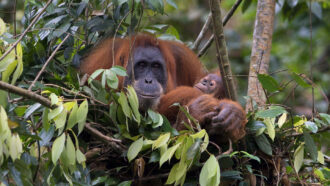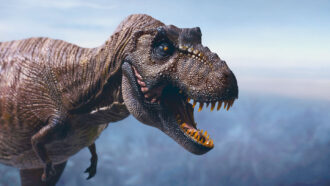Animals
-
 Animals
AnimalsThis biologist tracks seadragons, with help from the public
Nerida Wilson uses artificial intelligence to identify seadragons in photos taken by citizen scientists.
-
 Animals
AnimalsParrots may offer clues to how our intelligence evolved
Studies of the brainy birds’ abilities to use tools, solve puzzles, speak words and more may teach us about how our species got our smarts.
-
 Animals
AnimalsLet’s learn about orangutans
These shaggy, red-haired apes are more solitary than other primates, but moms and babies share a strong bond.
-
 Animals
AnimalsThe last woolly mammoths offer new clues to why this species died out
The last woolly mammoth herd experienced a drop in genetic variation. But this is likely not what doomed these majestic beasts to extinction, new data suggest.
By Claire Yuan -
 Animals
AnimalsMetal gives the teeth of Komodo dragons their super strength
Investigating Komodo dragons' ironclad teeth in greater detail could also help solve a dental mystery in dinosaurs.
-
 Animals
AnimalsA childhood dog inspired this veterinarian to help others
Sunday Agbonika runs the organization Dogalov, which uses animals to help support neurodivergent children in Africa.
-
 Animals
AnimalsFreeze-drying turned a woolly mammoth’s DNA into ‘chromoglass’
The 3-D structure of this now-glassy DNA revealed similarities — and differences — between woolly mammoths and elephants.
-
 Animals
AnimalsBalmy ‘saunas’ help frogs fend off a deadly fungus
Hanging out in small sun-warmed hideaways could help some frogs resist deadly chytrid fungus, a new study finds.
By Skyler Ware -
 Fossils
FossilsStunning trilobite fossils include never-before-seen soft tissues
Well-preserved fossils from Morocco help reveal the weird way trilobites ate and perhaps why these iconic animals went extinct.
-
 Brain
BrainJust how brainy was a T. rex?
A debate rages over how to count brain cells in dinosaurs. At issue: figuring out how these extinct animals’ likely behaved.
By Freda Kreier -
 Animals
AnimalsScientists Say: Beakiation
Parrots use this clever sidestepping motion to maneuver along thin branches.
-
 Animals
AnimalsWild medicine! An orangutan treated his wound with a local plant
This great ape, living in Indonesia, doctored the gash on his face with a plant that people living in the area use as a natural medicine.